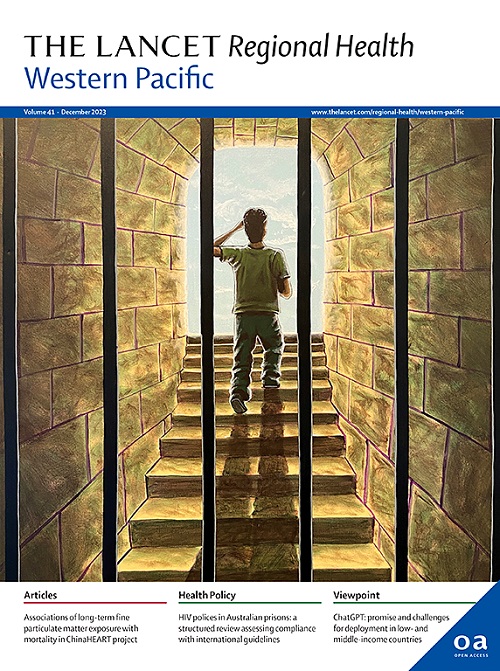Informing health system planning for biomarker-based treatment: statistical prevalence projections for solid cancers with key pan-tumour biomarkers (dMMR, MSI, high TMB) in Australia to 2042
IF 8.1
1区 医学
Q1 HEALTH CARE SCIENCES & SERVICES
引用次数: 0
Abstract
Background
Targeted cancer treatment based on mismatch repair deficiency (dMMR), microsatellite instability (MSI), or high tumour mutational burden (TMB) holds promise for improving patient outcomes, but presents substantial healthcare costs.
Methods
Using validated statistical methods, we projected 1-year to 5-year prevalence of individuals diagnosed with solid tumours exhibiting these biomarkers in Australia to 2042, for all solid cancers combined and 23 individual cancer types/groups, and separately for all stages combined, advanced disease at diagnosis (here, distant metastasis/lymph node involvement), and advanced disease after progression post-diagnosis.
Findings
The 5-year prevalence of individuals diagnosed with any solid cancer regardless of biomarker status is estimated to increase by 54·2%, from 438,346 in 2018 to 675,722 in 2042 (advanced disease at diagnosis: by 37·6% from 109,855 to 151,199), primarily due to population growth and ageing. The 5-year prevalence of individuals whose tumours exhibit a biomarker is estimated to increase accordingly, e.g. for advanced disease at diagnosis, from 3983 to 5448 for dMMR, from 2484 to 3553 for MSI, and from 13,310 to 17,893 for high TMB (representing 3·6%, 2·3% and 11·8% of 5-year prevalence of individuals with advanced disease at diagnosis, respectively; noting considerable overlap in the presence of these biomarkers).
Interpretation
We present the first long-term projections for cancer prevalence associated with key pan-tumour biomarkers in Australia, to inform health policy and healthcare planning for targeted therapies.
Funding
Medical Research Future Fund—Preventive and Public Health Research Initiative—2019 Targeted Health System and Community Organization Research Grant Opportunity (MRF1200535), Cancer Institute NSW Career Development Fellowship (2022/CDF1154), National Health and Medical Research Council of Australia Investigator Grant (APP1194679).

为基于生物标志物的治疗提供卫生系统规划信息:到2042年澳大利亚具有关键泛肿瘤生物标志物(dMMR、MSI、高TMB)的实体癌的统计患病率预测
背景:基于错配修复缺陷(dMMR)、微卫星不稳定性(MSI)或高肿瘤突变负担(TMB)的靶向癌症治疗有望改善患者的预后,但存在巨大的医疗成本。方法:使用经过验证的统计方法,我们预测了澳大利亚到2042年所有合并实体癌和23种单独癌症类型/组中被诊断为具有这些生物标志物的实体瘤个体的1年至5年患病率,并分别针对合并的所有阶段、诊断时的晚期疾病(此处为远处转移/淋巴结受累)和诊断后进展后的晚期疾病。无论生物标志物状态如何,被诊断患有任何实体癌的个体的5年患病率估计增加了54.2%,从2018年的438,346人增加到2042年的675,722人(诊断为晚期疾病:从109,855人增加到151,199人,增加了37.6%),主要是由于人口增长和老龄化。肿瘤表现出生物标志物的个体的5年患病率估计相应增加,例如,对于诊断时的晚期疾病,dMMR从3983增加到5448,MSI从2484增加到3553,高TMB从13310增加到17893(分别占诊断时晚期疾病个体5年患病率的3.6%,2.3%和11.8%);注意到这些生物标记物存在相当大的重叠)。我们提出了澳大利亚与关键泛肿瘤生物标志物相关的癌症患病率的第一个长期预测,为靶向治疗的卫生政策和医疗保健计划提供信息。资助医学研究未来基金-预防和公共卫生研究计划- 2019目标卫生系统和社区组织研究资助机会(MRF1200535),新南威尔士州癌症研究所职业发展奖学金(2022/CDF1154),澳大利亚国家卫生和医学研究委员会研究员资助(APP1194679)。
本文章由计算机程序翻译,如有差异,请以英文原文为准。
求助全文
约1分钟内获得全文
求助全文
来源期刊

The Lancet Regional Health: Western Pacific
Medicine-Pediatrics, Perinatology and Child Health
CiteScore
8.80
自引率
2.80%
发文量
305
审稿时长
11 weeks
期刊介绍:
The Lancet Regional Health – Western Pacific, a gold open access journal, is an integral part of The Lancet's global initiative advocating for healthcare quality and access worldwide. It aims to advance clinical practice and health policy in the Western Pacific region, contributing to enhanced health outcomes. The journal publishes high-quality original research shedding light on clinical practice and health policy in the region. It also includes reviews, commentaries, and opinion pieces covering diverse regional health topics, such as infectious diseases, non-communicable diseases, child and adolescent health, maternal and reproductive health, aging health, mental health, the health workforce and systems, and health policy.
 求助内容:
求助内容: 应助结果提醒方式:
应助结果提醒方式:


